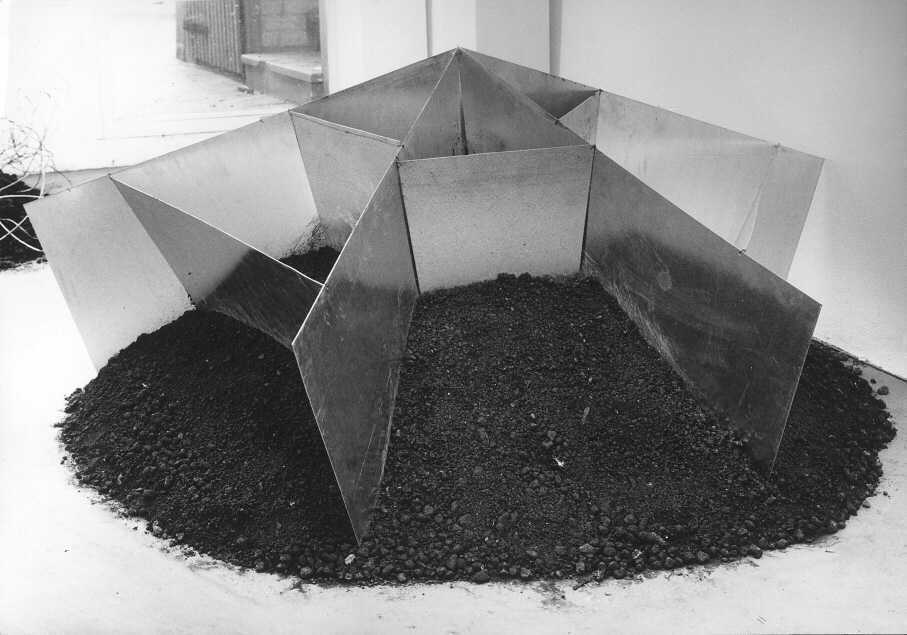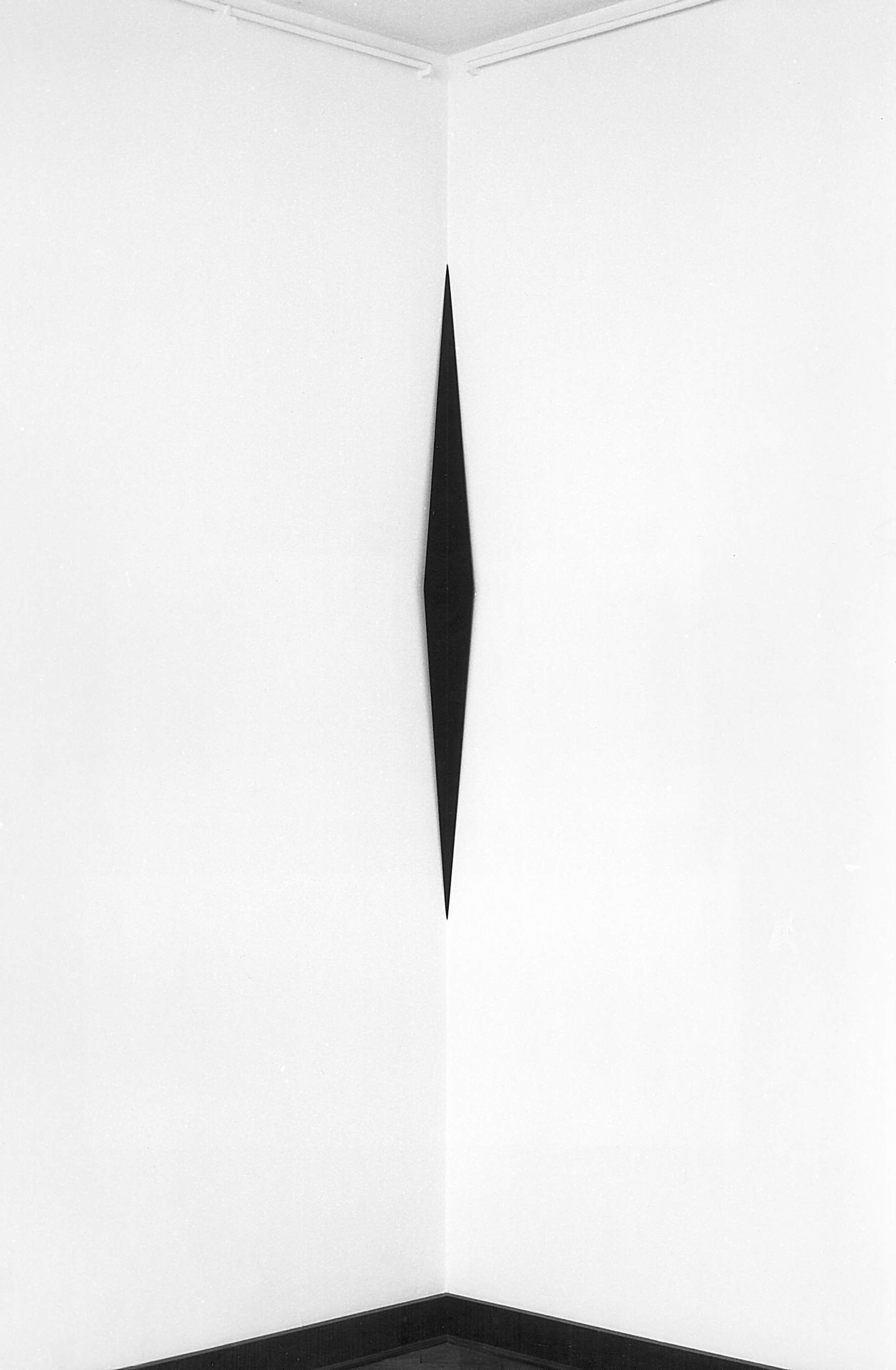
Ever slow on the uptake, I made it to the final days of Ruthenbeck last week. In truth, I went to the Serpentine to see Julio Le Parc but, having gone to the wrong Serpentine, I found myself confronted by three heaps of ash and metal instead of plastic and light shows. I'm glad, as Ruthenbeck forced me to evaluate things I haven't really plunged deeply enough into since returning to practicing as an artist.
There has been a palaver over the course of the exhibition, summed up nicely by
the Independent here, about the quality of the pieces and whether they constitute art or not. I'm pleased to say that as a consequence of going by accident I was absolutely unaware of this so it didn't colour my own thought process.
The exhibition begins with three of Ruthenbeck's cones and heaps, each of a different type of ash partially burying a different metal structure - the geometric one pictured, a wire one and one built of large square section steel tubes. There is always a temptation to react with fatigue when facing artwork of this type. Sculptures have drawn attention to their material nature for many decades now and is the fact that ash can have many different qualities really enough of an insight or aesthetic experience to excite? Three things save these pieces though - they were made in the late 1960's at a time when such investigations were not ten a penny, the fact they were shown in close proximity to each other instead of in isolation gave them added power and, on their own terms, they are beautiful.
Much of the next room is taken up with the upturned furniture discussed at length in the Independent so I won't add much except to say I have a major problem - the presentation. In the photo the Independent carries, someone is walking between the chairs and being able to freely move around the objects may have hugely increased their worth. As it is viewers were kept behind a black line on the floor. There seems to be a consensus that pieces like this are either drawing attention to the material and aesthetic nature of their parts (which I would favour in the context of Ruthenbeck's other pieces here) or are inviting the viewer to supply their own narrative element. Both of these possibilities were undermined by half-heartedly restricting viewpoints - either restrict them completely or don't restrict viewers at all. The narrative/dramatic element would have been transformed and strengthened by the presence of people amid the field of fallen furniture, and the formal investigation would have been more compelling had the viewer been able to see the objects and their relationships from different directions. As it is, young me would have raved about this piece whereas older and more critical me is, well, older and more critical and would suggest there is no honest way to say this is stronger or weaker and more or less interesting than any of the thousands of equivalent pieces kicking around the art world. I am always surprised that artists have not yet become bored of making such things, unless perhaps it is an attempt to take the modernist project of testing art by reducing things to their essentials and apply it not to Painting or to Sculpture but to the process of making art; a declaration that the only things fundamental to art are looking and thinking.
The third room was filled with structures combining a sensuously deep red fabric with welded metal and, on occasion, clear plastic. Again they address themes of materiality and geometry but I can't help but feel such things are more interesting to make than they are to look at. Another difficulty was the presence of a suitcase broadcasting Fluxus music - the strength and weakness of sound based work is the way it disrupts everything around it and I believe in this case it was a hindrance more than a help.
The final room is the one with the most intriguing idea, and the one that chimes most with my own interests. It is a large square room, a former courtyard, and it is almost blacked out. Light comes from a single, dim orange bulb in the centre of the room and is intended to recreate twilight - specifically the amount of light at which one cannot tell the difference between a dog and a wolf. That is an inherently interesting boundary to inhabit, and an interesting way to define it. Sadly, the piece didn't quite live up to expectations - but then nothing could. Having the light barely strong enough that you can walk into the room safely meant that when my eyes had fully adjusted I could see far too clearly. Equally, by definition twilight cannot be tamed - it is constantly changing both brightness and colour and, as the phrase the phrase about the dog and the wolf suggests, is accompanied by things that play on senses other than vision. Without the explanation and the title it was a fascinating and rewarding room for stopping and just existing in. Without the room, the idea was intriguing and beautiful. Sadly though, each undermines the other just enough to render this a missed opportunity.

I have saved what I think the best pieces until last. They were perhaps the simplest yet among the most sophisticated. In one, a single, elongated parallelogram is bent in half along the long axis to an acute angle. It is then fastened to the corner of a room by a single screw. The satin black of the metal and the stark white of the wall along with the acute angle of the metal and the right angle of the wall and the single familiar point of reference provided by the screw head interacted optically, distorting both space and material. In the other, in the fabric and metal room, the shape was repeated. This time it was the fabric wrapped around four pins in the wall. The fabric, being nearly edge-on to the viewer appeared to be a dark and colourless line. The white wall picked up the reflected colour from the red and took on a phenomenally delicate rose tint which faded imperceptibly to nothing over a couple of inches. The strength of my reaction to them compared to everything else surprised me.
The great strength of this exhibition (and it is a strong exhibition in spite of my apparent harshness) is that it forces the viewer to actually do that most clichéd of acts - using the basic stuff-ness of appropriated objects and materials it genuinely and forcefully encourages the viewer to consider their own idea of art. For me, the parallelograms and the twilight held the key. These were the pieces that actually achieved what I think the fallen furniture was trying to do: they proudly displayed their nature and then transcended it. This realisation absolutely defines what art I respond to and why I'm a painter. In a painting, the flat surface covered in marks is also a moment of space or volume or light in exactly the same way that the white wall was a rose-coloured wall. Painting, for me, is the ultimate expression of a material transcending itself. It is where everything is contradiction and nothing is free of ambiguity. Painting is the twilight where dog and wolf are the same.
Any exhibition that can give so much insight into one's own practice has to be applauded. Reiner Ruthenbeck and all at the Serpentine, take a bow.
http://www.reiner-ruthenbeck.de
 A lot of the late summer was spent as Artist in Residence at Sulgrave Manor in Northamptonshire. Built by the ancestors of George Washington, it is a modest Tudor manor full of Tudor furniture and I was privileged enough to be given fantastic access to it. Seeing as today the Manor places a large emphasis on making the past come alive, I looked for ways I could do that visually. In the end, I used it as a vehicle to explore the absence of electric light - what the mind does to shadows and sound when there is no way to make darkness disappear and trying to imagine what darkness might have been to people who would not have had any conception of electric light. This had the added bonus of picking up on discoveries from my work with nocturnes. There was a real temptation to build nightmares into the shadows, but I resisted and played it straight. Anything you see in them is what is already in your own mind.
A lot of the late summer was spent as Artist in Residence at Sulgrave Manor in Northamptonshire. Built by the ancestors of George Washington, it is a modest Tudor manor full of Tudor furniture and I was privileged enough to be given fantastic access to it. Seeing as today the Manor places a large emphasis on making the past come alive, I looked for ways I could do that visually. In the end, I used it as a vehicle to explore the absence of electric light - what the mind does to shadows and sound when there is no way to make darkness disappear and trying to imagine what darkness might have been to people who would not have had any conception of electric light. This had the added bonus of picking up on discoveries from my work with nocturnes. There was a real temptation to build nightmares into the shadows, but I resisted and played it straight. Anything you see in them is what is already in your own mind.


